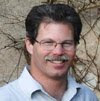Once the top was shaped, flattened and sanded, it was time to tackle the base. The base of this table consists of only four parts. The legs and bottom rail are half-lapped together, which is a pretty simple joint to cut, normally, but in this case the legs are canted out at a 10 degree angle. Cutting the angled joint is still pretty straightforward, but requires an extra jig, and some thoughtful planning.
The secret to a well-fitting joint is to do all the angled milling operations with the same table saw blade setup. After setting the blade to 10 degrees, I first trimmed the top and bottom faces of the legs. Next, without moving the blade, I cut the angled half-laps in the bottom rail. To do this, I used a crosscut sled. You can also see in the photo how the rip fence and a stop block defined the limits of the cut as the material is nibbled away. That meant that I could cut both sides with only a single setup by just flipping the rail, yielding two dadoes exactly the same size and perfectly symmetrical.
While the blade was still tilted, I also cut the front and bottom parts for the leg dadoing jig. This jig was used in conjunction with my normal 90 degree crosscut sled to cut the mating dadoes in the legs. Stop blocks again defined the limits of the cut, and allowed me to cut both legs with a single setup. The same sled setup was also used to cut the dadoes for the upper rail.
The ragged edges left by nibbling with the table saw were cleaned up with a chisel, and with all the joint halves cut using only two setups, there was no doubt that the joint would fit properly.
Now that the joinery was cut, the various parts could be shaped. First, the bottom rail's upper half was given a parabolic arched profile. Using a paper template, the shape was drawn onto the rail ends, and the majority of the waste material removed with a couple of passes on the table saw. The profile was then refined with a plane, scraper, and sander. By
leaving the lower half of the rail square, the joint was fully
maintained.
Shaping of the legs was done in two steps. First, the outer edges were curved to give a softened trapezoidal outline. This was done on the band saw, and then faired with a belt sander.
Next the sides of each leg were given a thumbnail profile. This was done by first laying out a center line down the face and relief lines on each side, then using a compass to lay out the curve.
Then it was back to the plane and sander to fair it all out. The base was now complete and ready for finishing.














